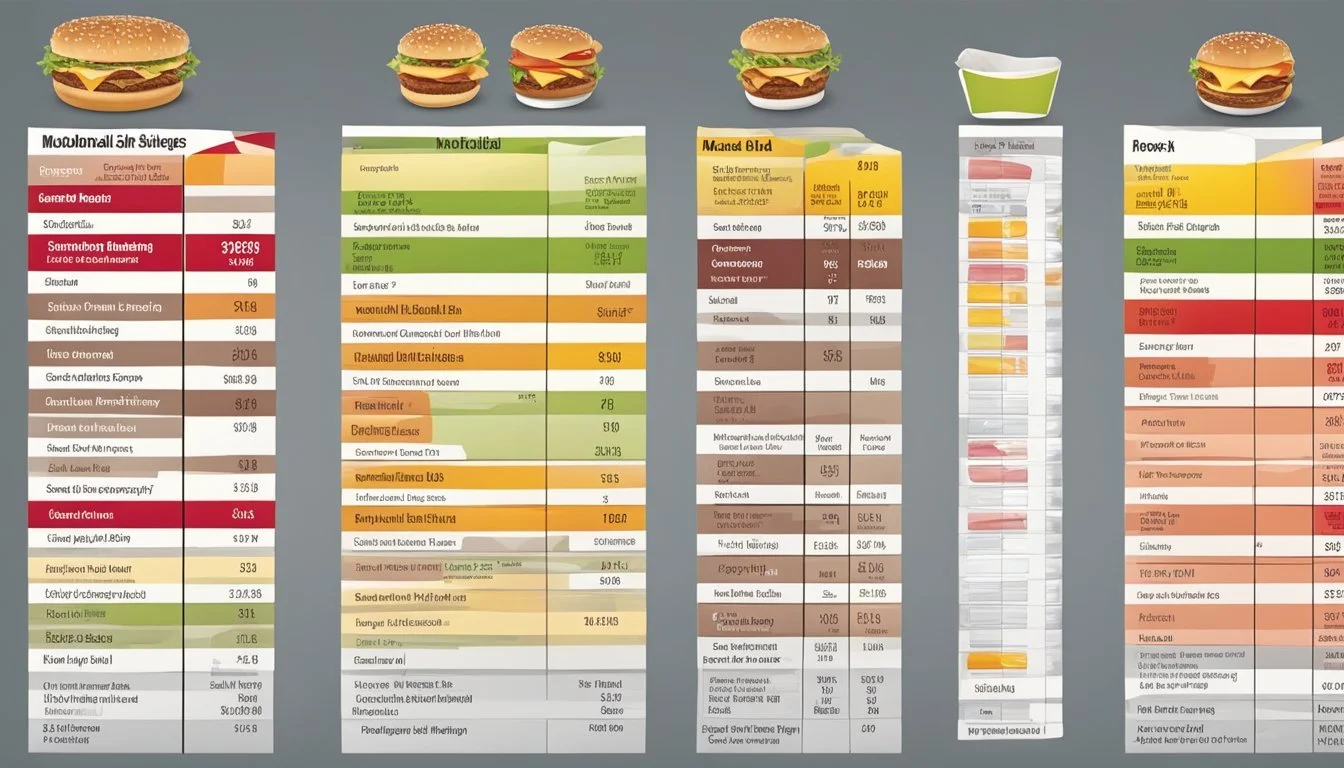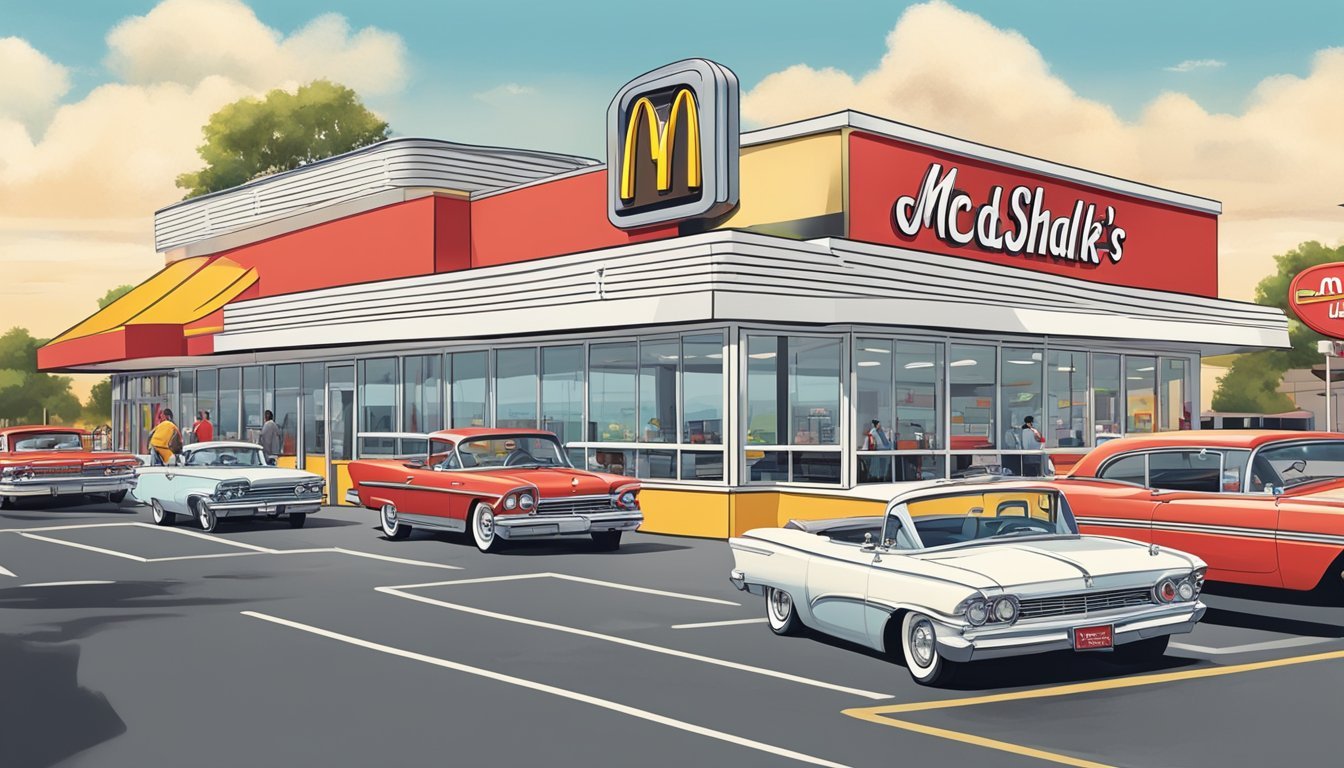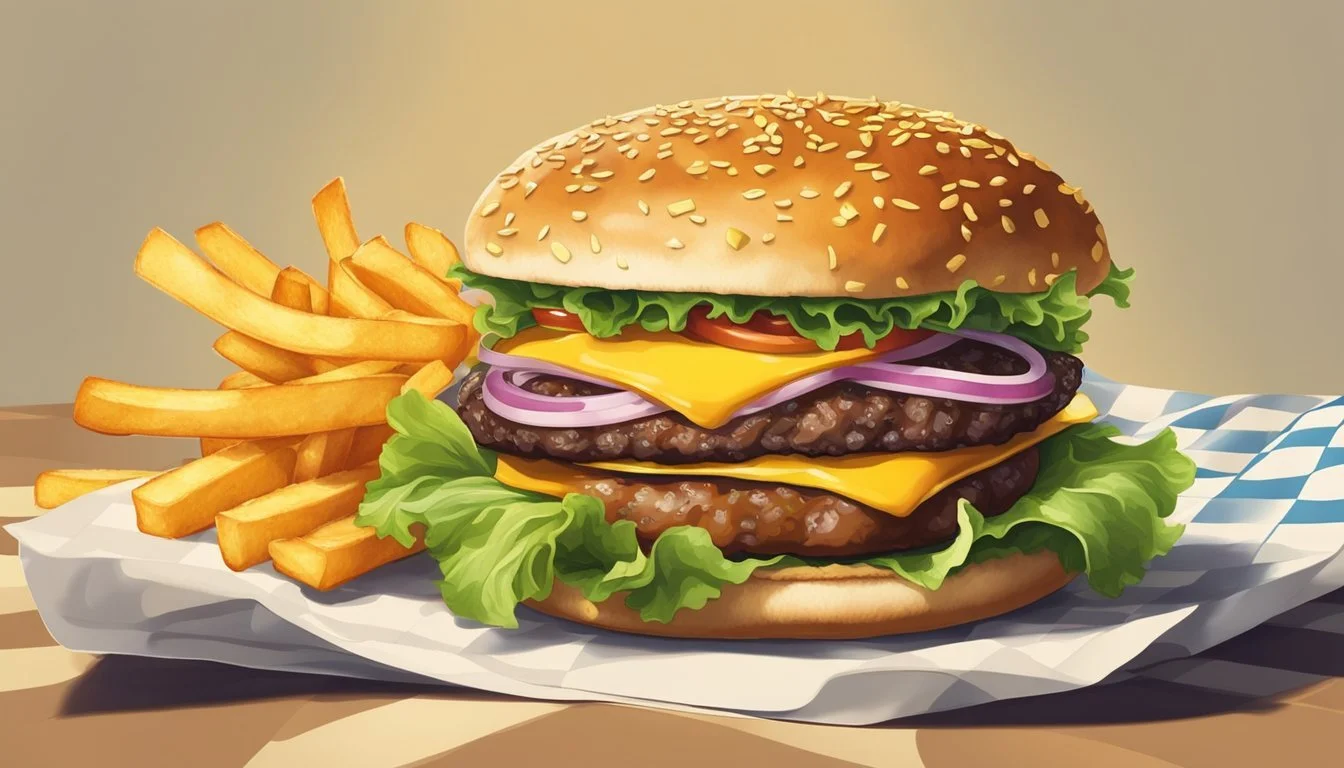McDonald's vs Steak 'n Shake
Comparing Burger Quality and Dining Experience
When it comes to iconic fast food fare, burgers are perhaps the most universally recognized centerpiece across various chains. In the landscape of American fast food, McDonald's and Steak 'n Shake stand as two stalwarts offering their unique takes on the humble hamburger. McDonald's, with its global presence and quick-service approach, has been a fixture for decades, known for its consistent taste and efficient service. Touting a variety of burgers from the classic Big Mac to the simple cheeseburger, it caters to a broad audience.
Steak 'n Shake, by contrast, positions itself several notches above the standard fast-food experience with a diner-esque ambiance and a focus on table service. Their burgers, branded as "Steakburgers," claim a higher quality of beef and a more traditional, crafted approach. Customers often associate Steak 'n Shake with a sit-down restaurant feel, enjoying burgers that are made-to-order with a more pronounced emphasis on taste and presentation.
In analyzing which burger joint is better, one examines not only the quality of the burgers themselves but also the overall dining experience provided by each establishment. Factors such as menu variety, flavor, service speed, price, and ambiance contribute to the holistic experience of the patron. McDonald's represents the epitome of fast-food efficiency and familiarity, while Steak 'n Shake offers an experience that harkens back to classic American diners, promising a more premium burger. Each has its merits, and the preference for one over the other may come down to the individual's expectations and tastes.
History and Brand Overview
When comparing McDonald's and Steak 'n Shake, it is essential to consider their origins and brand evolution, as each offers a unique story of development within the American fast-food landscape.
McDonald's: A Global Fast Food Leader
McDonald's began as a barbecue restaurant in 1940, founded by Richard and Maurice McDonald in San Bernardino, California. It swiftly transitioned to a hamburger stand with a streamlined production method inspired by the assembly line, which catapulted it into global prominence. Ray Kroc, a businessman, played a pivotal role in McDonald's expansion by buying the franchise rights and opening the first franchised restaurant in Des Plaines, Illinois, in 1955. McDonald's has since grown into an iconic fast-food behemoth; as of 2024, it operates in over 100 countries with tens of thousands of restaurants, solidifying its status as a global leader in fast food.
Steak 'n Shake: An American Classic
Steak 'n Shake's journey began in 1934 when Gus Belt converted a gas station in Normal, Illinois, into a pioneering burger stand with a focus on quality. Its distinctive offering was the 'steakburger', a burger made from a mixture of T-bone, sirloin, and round steaks. The name "Steak 'n Shake" originates from Belt's catchphrase, "In Sight It Must Be Right," as he would wheel in a barrel of steaks and grind the meat in front of the customers. This transparent practice showcased the quality and freshness of the ingredients. Although confronting financial difficulties in the 2000s, the brand witnessed a resurgence by late 2009. Steak 'n Shake has forged a reputation for affordable, sit-down burger meals and hand-dipped milkshakes, making it a distinct and cherished component of America's fast-food fabric.
Menu Comparison
When comparing the menus of McDonald's and Steak 'n Shake, one can notice significant differences in their burger offerings, iconic dishes, and dessert options, each carrying its unique flair.
Burger Varieties
McDonald's has a globally recognized burger lineup, with the Big Mac and Quarter Pounder standing as cornerstones. The Big Mac is known for its special sauce and three-part sesame seed bun, while the Quarter Pounder aims at those preferring a straightforward, meatier burger.
Steak 'n Shake, on the other hand, boasts a variety of steakburgers like the Wisconsin Buttery Steakburger, noted for its buttery crown and indulgent flavor. They offer a unique take with toppings such as real Wisconsin butter, which is not a common find in other fast-food chains.
Signature Items
Each brand carries signature items that define their identity:
McDonald's:
Big Mac: Two beef patties, special sauce, lettuce, cheese, pickles, onions, on a sesame seed bun.
Quarter Pounder: Highlights a quarter pound of pure beef with a focus on simplicity and taste.
Steak 'n Shake:
Original Steakburger: Known for its steak quality ground beef patty paired with classic toppings.
Western BBQ 'N Bacon Steakburger: Combines the savory taste of barbecue and bacon for a bold flavor.
Dessert Selections
McDonald's is known for their iconic desserts such as the McFlurry, a creamy soft-serve ice cream available with various mix-ins. The simplicity of their desserts is a draw with options including the classic Apple Pie.
Steak 'n Shake maintains a traditional American diner feel with their selection. Milkshakes are a highlight on their dessert menu, with a variety of flavors that complement their meals. Classic flavors stand alongside seasonal offerings, often paired with their meals for a complete dining experience.
In summary, both menus provide customers with an array of choices whether they are looking for a classic burger or a more specialized option. Each chain's dessert offerings provide a sweet finish to their meals, from McDonald's McFlurry to Steak 'n Shake's hand-dipped milkshakes.
Quality of Ingredients
In comparing McDonald's and Steak 'n Shake, it is crucial to consider the quality of ingredients. Specific focus areas include the sourcing of meat, the freshness of produce, and the variety of bread options.
Sourcing of Meat
McDonald's has often faced scrutiny over its use of frozen beef patties, whereas Steak 'n Shake emphasizes their use of 100% fresh Midwest beef. McDonald's, in response to market demands and competitors like Wendy’s and Burger King, began introducing fresh beef in some of their burgers, such as the Quarter Pounder. However, Steak 'n Shake maintains that its steak burgers are made from a blend that includes brisket, ensuring a distinctive taste and quality.
Freshness of Produce
Both establishments boast the inclusion of fresh produce on their burgers. McDonald's sources a variety of vegetables like lettuce and tomatoes to add to their burgers, which are prepared daily. Steak 'n Shake also prides itself on using fresh produce, which is a standard expectation in the industry, mirrored by competitors like In-N-Out, known for their fresh ingredients.
Bread Options
The choice of bread can significantly affect the overall taste and quality of a burger. McDonald's provides a standard sesame seed bun for most of its burgers, whereas Steak 'n Shake offers lightly toasted, buttered buns. While not revolutionary, the toasting process can add to the flavor profile and texture, differentiating it from softer, untoasted buns often found at fast-food chains.
Both restaurants take measures to serve their customers quality ingredients, but the approach and specifics do differ, providing distinctive dining experiences with regard to the freshness and source of their burger components.
Taste and Flavor Profiles
In assessing McDonald's versus Steak 'n Shake, taste and flavor profiles are pivotal. Each establishment presents its own distinct approach to the classic American burger, employing different strategies to satisfy their diners' palates.
Classic Flavors
McDonald's has become a mosaic of the fast-food world with its straightforward, yet iconic flavor profile. The classic McDonald's burger is a combination of a beef patty, ketchup, mustard, pickles, and diced onions, often layered with a slice of American cheese. It's a model of consistency; diners know exactly what to expect with each bite.
Steak 'n Shake, on the other hand, stakes its reputation on the "Steakburger". The primary allure of their burgers is the use of steak cuts, grounding them into burgers to elevate the taste. These burgers are traditionally adorned with toppings like lettuce, tomato, cheese, and sometimes, more gourmet additions like bacon and artisanal breads, aiming to meld classic diner tastes with a touch of refinement.
Gourmet Twists
When it comes to a more gourmet twist, Steak 'n Shake stands out with menu items such as the Wisconsin Buttery Steakburger, noted for its richness and blend of buttery flavor. This premium burger is often highlighted for special occasions and demonstrates the chain's commitment to elevate the standard burger fare.
McDonald's, while mainly associated with fast and familiar flavors, occasionally experiments within its lineup. Offerings like the Quarter Pounder and Big Mac venture beyond the basics with their signature sauces and double layering of beef, demonstrating that McDonald's can also cater to those looking for a more robust burger experience.
Seasonal Offerings
Both chains occasionally introduce seasonal offerings to entice the palate of adventurous eaters. McDonald's limited-time specials have included variations with unique sauces or seasonal toppings, playing with expectations while staying true to their classic taste principles.
Steak 'n Shake often integrates seasonal flavors into its menu, sometimes in the burger selections and frequently within its vast milkshake range. From holiday-inspired shakes to summer burger concoctions, they pivot on the traditional taste to offer temporarily available gustatory delights, blending the familiar with a taste of the season.
Customer Experience
When considering the customer experience at McDonald's versus Steak 'n Shake, it's important to assess service speed, atmosphere, and cleanliness. These factors directly affect a patron's dining experience and their likelihood to return.
Service Speed
McDonald's is renowned for its quick service. With its effective drive-thru system and a time-tested fast food model, customers usually receive their orders within minutes. Steak 'n Shake, on the other hand, tends to have a sit-down restaurant approach, which can mean longer wait times for food preparation and service. The difference is most striking during peak hours when the fast-paced McDonald's system serves many customers efficiently.
Atmosphere
Steak 'n Shake offers a diner-style atmosphere that harkens back to classic American eateries, complete with a sit-down service and a retro feel. McDonald's atmosphere is more utilitarian, with a focus on convenience and speed. Lighting, music, and decor at Steak 'n Shake create a more relaxed environment compared to the often bustling and straightforward seating arrangements found at most McDonald's locations.
Cleanliness
Both establishments prioritize cleanliness, but their operational models influence their success in maintaining it. McDonald’s, with its high turnover in foot traffic, especially in inner-city locations, faces the constant challenge of keeping dining and restroom areas clean. Steak 'n Shake, with its fewer but longer-staying customers, generally maintains a cleaner dining area throughout the day. Nevertheless, both McDonald's and Steak 'n Shake adhere to the health and safety standards set by food service regulations in America.
Nutritional Information
When comparing McDonald's and Steak 'n Shake, it's important to consider the nutritional content of their offerings, particularly for those counting calories or seeking healthier options.
Caloric Content Analysis
McDonald's:
Hamburger: 241 calories
Chicken Sandwich (Crispy): Generally around 500-600 calories
Milkshake (medium-sized): Approximately 530-560 calories, depending on the flavor
Steak 'n Shake:
Single Steakburger without Cheese: 320 calories
Bacon 'n Cheese Triple: 1,030 calories
Milkshake: Caloric contents can vary, but are generally comparable to McDonald's servings
McDonald's offers a nutrition calculator on their website, allowing customers to customize their order and obtain specific calorie counts. Steak 'n Shake provides nutritional information that guides customers looking to control their caloric intake, such as opting for a burger without the bun for a lower-carb meal.
Health-Conscious Options
McDonald's has incorporated healthier items into their menu, like salads and grilled chicken sandwiches, offering alternative choices lower in calories than their traditional burgers and milkshakes.
Likewise, Steak 'n Shake provides options for those seeking fewer calories, such as removing the bun from their burger or choosing smaller portions. Customers can create their own lower-carb, higher-protein meal by customization.
Both establishments cater to a variety of dietary needs, but as always, it is up to the individual to make informed choices based on their own health and nutritional goals.
Pricing and Value
When comparing McDonald's and Steak 'n Shake, it's essential to examine the cost and overall value, particularly looking at classic menu items, combo deals, and loyalty programs to discern which establishment offers a more economical experience for the consumer.
Cost of Classics
McDonald's:
Big Mac: $3.99
Cheeseburger: $1.00
Steak 'n Shake:
Original Double 'n Cheese Steakburger: $3.99
Single Steakburger: $3.49
The signature burgers at each chain are competitively priced, with Steak 'n Shake's offerings like their Original Double 'n Cheese Steakburger being comparable in cost to McDonald's iconic Big Mac. However, Steak 'n Shake positions itself as a slightly higher tier, reflected in the pricing of their single patty burgers.
Combo Deals
McDonald's:
Classic Meal Deal (Big Mac, medium fries, and a drink): $5.99
2 for $5 Mix & Match Deal includes Big Mac: $5.00
Steak 'n Shake:
Steakburger, fries, and drink combo: Around $7.00
4 for $4 Deal includes Double Steakburger and fries: $4.00
Combo deals at McDonald's, such as their Classic Meal Deal, are typically less expensive than Steak 'n Shake's equivalent offering, making McDonald's the more cost-effective option for a full meal. Steak 'n Shake's 4 for $4 deal does provide value but with a smaller burger.
Loyalty Programs
McDonald's:
MyMcDonald’s Rewards program: earn points on every purchase redeemable for free items.
Steak 'n Shake:
Rewards Club: receive points, exclusive deals, and a free milkshake upon first purchase with app download.
Both chains boast loyalty programs designed to offer additional value to frequent customers. McDonald's has a point-based system centered around a variety of free items, which encourages repeat patronage. Steak 'n Shake rewards its customers not only with points but also with appealing sign-up incentives, like a complimentary milkshake, aiming to offer immediate gratification.
Brand Presence and Marketing
In the fast-food landscape, McDonald's and Steak 'n Shake have carved out distinct brand presences and marketing strategies. The former's global reach and innovative campaigns contrast with the latter's focus on traditional diner appeal and recent profit-based partnership models.
Advertising Campaigns
McDonald's has established a commanding lead with its iconic "Golden Arches," symbolizing a consistent consumer experience across over 100 countries. Its advertising campaigns often feature emotional connections and global narratives that transcend mere food, speaking to a larger lifestyle promise. The brand has been an industry pioneer, introducing drive-thru service during the 1970s, further solidifying its place in the fabric of fast-food culture.
Conversely, Steak 'n Shake's presence is less about global narratives and more about emphasizing its classic American diner experience. Historically less expansive in its advertising reach, Steak 'n Shake has focused more on its heritage, diner-like atmosphere, and its 'Steakburgers' to attract customers, rather than large-scale, emotive campaigns.
Social Media Influence
McDonald's excels in leveraging social media platforms to connect with younger audiences. They use Twitter, Facebook, Instagram, and TikTok to engage customers with a mix of interactive content, promotions, and timely posts related to current trends. Their strategy is evidence of adapting to emerging marketing trends and maintaining a strong online presence to complement their physical outlets.
Steak 'n Shake lags behind in social media influence when compared to McDonald’s. However, its customer engagement is more localized and may resonate on a more personal level with its niche audience. They emphasize promoting special deals and nostalgic imagery that reflects their long-standing brand identity.
Merchandising
Merchandising is yet another area where McDonald's has made significant strides. Beyond food, it offers a range of branded merchandise, capitalizing on its ubiquity and cultural impact. McDonald’s often partners with popular brands and franchises for limited-edition merchandise, adding to its marketing appeal.
Steak 'n Shake offers less in terms of branded merchandise but focuses instead on the profitability of its franchise model. The company's strategy includes selling company locations to operating partners who pay an initial fee and split profits with the brand, exemplifying a business-centered marketing strategy rather than consumer merchandise offerings.
While other entities like Culver’s and BurgerFi also participate in the burger joint spectrum, they each have a unique approach to their marketing, which often includes focusing on regional preferences and emphasizing their own distinctive quality propositions, such as using fresh, locally sourced ingredients or offering a more upscale burger experience.
Customer Loyalty and Retention
In the competitive landscape of burger joints, McDonald's and Steak 'n Shake place significant emphasis on customer loyalty and retention strategies.
Repeat Business Metrics
Both McDonald's and Steak 'n Shake understand that loyal customers are more likely to offer repeat business, which is a key performance indicator in the fast-food industry. McDonald's loyalty program is an initiative designed to foster such repeat business. It was expected to be launched in its top six global markets by mid-2022. By rewarding customers for their patronage, the program aims to drive consistent traffic to its restaurants.
Steak 'n Shake's approach has seen a shift to counter service and the introduction of kiosks, which can streamline the customer experience and potentially increase the frequency of visits.
Brand Advocacy
McDonald's boasts a global presence and a reputation that often turns its customers into brand advocates. This advocacy is crucial, as it signifies an emotional commitment that goes beyond a transactional relationship. Similarly, other successful burger chains like In-N-Out Burger and Shake Shack have cultivated a strong base of loyal customers, with In-N-Out Burger, in particular, benefiting from a regional cult following that passionately advocates for the brand.
Steak 'n Shake, amid its service model changes, remains insistent on transforming restaurants to adapt to the evolving demand, hoping to convert its customers into strong brand proponents. The fast-food chain's attempts to revitalize its customer service through these changes reflect their understanding of the importance of not just retaining customers but also empowering them to become active brand ambassadors.
Expansion and Franchise Model
The expansion and franchise models of McDonald's and Steak 'n Shake tell two very distinct stories. McDonald's has leveraged its franchise model to achieve impressive global presence, while Steak 'n Shake has experienced a more tumultuous path with significant restructuring to revitalize its strategy.
Global Reach
McDonald’s has established an immense global reach, with over 38,000 locations across more than 100 countries. This massive expansion can be attributed to its successful franchise model, which allows for scalability and local adaptability.
Franchise-owned Stores: Approximately 93% of McDonald's outlets are owned by franchisees.
Global Markets: Key markets include the United States, Australia, Canada, France, Germany, and the UK, among others.
Steak 'n Shake, in contrast, does not have a global footprint comparable to McDonald’s. It operates primarily in the United States, with a smaller presence internationally. Smashburger also trails in comparison, with a focus on the U.S. market, though it has started to branch out into a few international locations.
Franchise Opportunities
McDonald’s has a robust and highly sought-after franchising program, which requires a considerable investment from potential franchisees, including an initial franchise fee, monthly rent, and a percentage of sales. McDonald's provides extensive support and training to its franchisees, which is a cornerstone of its enduring success.
Initial Franchise Fee: Generally, $45,000.
Estimated Initial Investment: $1,008,000 - $2,214,080 excluding real estate costs.
Steak 'n Shake has also, as of recent reports, offered a unique franchising model, the "franchise partnership program," which aims to recruit single-unit operators with a substantially lower upfront investment of $10,000. This was part of an attempt to turn around the business after facing financial challenges. This approach is notably different from the traditional franchise model and targets entrepreneurial-minded individuals.
Upfront Investment: An accessible $10,000 to encourage owner-operators.
Turnaround Effort: The brand is focused on structural changes and financial recovery through this franchising effort.
McDonald’s continues to thrive with its established franchise model that drives continuous growth. Meanwhile, Steak 'n Shake’s franchise partnership program represents a strategic pivot aimed at fostering a more sustainable and profitable business structure. Both models offer different opportunities and challenges for potential franchisees in the competitive fast-food landscape.
Social Responsibility and Sustainability
McDonald's and Steak 'n Shake have increasingly emphasized their roles in social responsibility and sustainability. The efforts are designed to appeal to a socially-conscious customer base and mitigate environmental impacts.
Environmental Initiatives
McDonald's has been proactive with its environmental initiatives, recognizing that the longevity of its operations is dependent on sustainable practices. The company has adopted several measures that contribute to reducing their environmental footprint:
Sustainable Packaging: Transitioning to renewable, recyclable, and certified packaging materials.
Energy Efficiency: Implementing energy-saving equipment in restaurants.
Steak 'n Shake, while less publicized regarding its sustainability actions, also aims to implement measures for reducing its environmental impact. Their initiatives may include:
Eco-Friendly Operations: Efforts to optimize resource usage within their kitchens and dining areas.
Neither McDonald's nor Steak 'n Shake currently include Culver's or sliders as a focus area in their published sustainability reports or corporate responsibility statements.
Community Engagement
McDonald's showcases a robust community engagement strategy that aligns with its corporate responsibility framework. Key aspects include:
Local Involvement: Engaging with communities to support local needs and initiatives.
Nutritional Education: Promoting balanced diets and supporting programs related to nutrition awareness.
Steak 'n Shake has also demonstrated effort in contributing to the communities where it operates:
Charitable Activities: Participating in fundraisers and donations to support community projects.
In their respective approaches to community engagement and environmental stewardship, both brands reflect a commitment to playing a positive role in society, although McDonald's has a more globally visible presence in these areas.
Conclusion
In the landscape of American fast food, McDonald's and Steak 'n Shake each hold their own with unique offerings. McDonald's is widely recognized for its global presence and extensive menu. It appeals to a larger audience by providing a variety of burgers and other fast-food options. The Golden Arches are known for consistency and convenience, with innovations like updated cooking techniques to enhance the flavor and juiciness of their burgers.
Steak 'n Shake, boasting a legacy since the 1930s, distinguishes itself with the "steakburger" signature. They emphasize quality and tradition, serving burgers and hand-dipped shakes in a diner-style atmosphere. Their approach targets customers seeking a classic American burger experience. The focus on freshly prepared, straightforward burgers with real steak and hand-dipped milkshakes has created a loyal following, despite any past fluctuations in market presence.
When comparing the burgers themselves:
McDonald's stands out for quick service and uniform taste.
Steak 'n Shake is noted for steakburgers and table service reminiscent of a sit-down restaurant.
For milkshakes, McDonald's offers a convenient choice, but the quality may not match the thicker, more traditional milkshakes at Steak 'n Shake, which are often cited for their superior taste and texture.
Consumers' preferences between McDonald's and Steak 'n Shake often hinge on whether they prioritize the speed and familiarity of McDonald's or the sit-down, quality-focused experience of Steak 'n Shake. Each establishment serves a different customer base within the fast-food spectrum, and both have carved out a niche that caters to particular tastes and dining expectations.











